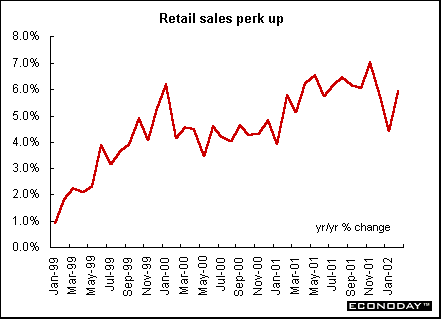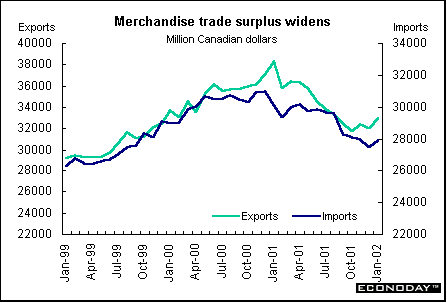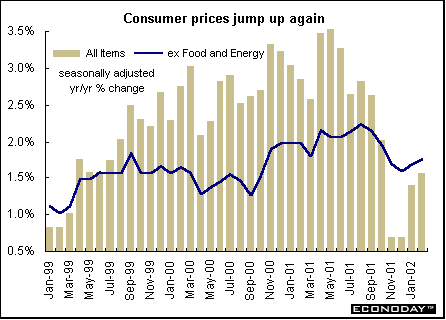
Indicator scoreboard
EMU - February harmonized index of consumer prices rose 0.1 percent and 2.4 percent when compared with last year. Core inflation (excluding energy, food, alcohol and tobacco) rose 2.5 percent on the year.

January non-seasonally adjusted merchandise trade deficit with the rest of the world was E0.6 billion compared with an E5.8 billion deficit in the year-ago. December's trade balance was revised down to a surplus of E8.4 billion from an originally reported surplus of E8.7 billion. Exports fell 5 percent and imports fell 11 percent on the year.
Germany - January seasonally and workday adjusted manufacturing orders were revised up to a decline of 1.0 percent from an initially reported reading of a 2.1 percent drop. West German orders were revised to a decline of 1.2 percent from the originally reported 2.1 percent drop. East German orders were revised to an increase of 1.1 percent from a decline of 1.2 percent. Foreign orders were revised up to a decline of 0.3 percent from an original reading of a 2.4 percent drop, while domestic orders were revised up to a 1.4 percent drop from the originally reported 2.1 percent slide.

France - February seasonally and calendar adjusted consumer spending on manufactured goods rose 0.4 percent and was up 1.0 percent when compared with last year. Private consumption remains the sole source of domestic growth, with recovery of exports and investments dependent on economic recovery in the United States. Spending rose in all main categories except autos. Excluding the auto sector (and medical products), spending was up 0.9 percent on the month but only 0.5 percent higher on the year.

Britain - February retail price index (RPI) rose 0.3 percent and 1 percent when compared with last year. The retail price index (RPIX), which excludes mortgage interest payments, rose 0.2 percent and 2.2 percent on the year. The Bank of England uses the RPIX to measure underlying inflationary pressures in the economy. Their target rate of inflation is 2.5 percent.

Average earnings growth for the three month to January rose 2.7 percent when compared with the same three month a year ago. This was the lowest level since the current series began in March 1991. January average earnings rose 2.4 percent on the year. The slowdown in growth was due to lower bonuses in January when compared with last year.

January claimant count unemployment fell 5,000, after a revised 9,700 decline in December. The unemployment rate was 3.1 percent. The unemployment rate based on the International Labour Organization definition for the three months November through January remained at 5.1 percent. Employment rose by 23,000 jobs in the three month through January when compared with the previous three months. Manufacturing jobs continued to drop and were down 158,000, or 4.1 percent, when compared with a year earlier.

February seasonally adjusted retail sales volumes rebounded from two consecutive monthly declines and rose 1.5 percent and 5.9 percent when compared with last year. This was the highest monthly gain in over two years. The jump in sales was driven by predominantly non-food sales, which rose 2.5 percent on the month. Clothing and footwear volumes rose 3.6 percent and 11.3 percent on the year. Significant gains were also seen elsewhere in household goods stores sales, up 2 percent and 8 percent on the year; non-specialized stores, up 1 percent and 6.9 percent on the year; and food sales, up 0.4 percent and 2.5 percent on the year.

Asia
Japan - February seasonally adjusted merchandise trade surplus rose 0.7 percent but shrank 11.3 percent when compared with last year. Exports rose 1.6 percent but fell 4.2 percent from a year earlier to decline for the 11th straight month. Imports slid 2.4 percent on the year, falling for the seventh straight month as weak domestic demand continued to weigh on purchases of foreign goods. The politically sensitive trade surplus with the United States expanded 0.1 percent from a year earlier. Steel exports to the United States jumped 24.6 percent when compared with last year. Exports of automobiles surged 21.9 percent from the year earlier, led by a 25.3 percent jump in shipments to the United States and a 10.6 percent rise in shipments to the European Union. Imports of clothing surged 19.1 percent, led by a 22.0 percent rise in imports from the Asian region.
Americas
Canada - January manufacturing shipments jumped 3.1 percent. The increase in manufacturing activity was widespread across industries, and only the second since August. Eighteen of 21 industries, representing 91 percent of total shipments, reported higher values. In addition, manufacturers continued to trim their inventories for the eighth consecutive decline. As a result, the inventory/shipment ratio fell sharply to 1.49, its lowest since May and down significantly from October's recent high of 1.56. Unfilled orders fell 0.8 percent, the lowest since September 1999. However, new orders more than recovered from a low December, rising 3.9 percent.
January merchandise trade surplus rose to C$5.1 billion, the highest since May 2001. Exports jumped 3.1 percent while imports rose 1.6 percent. The growth in merchandise exports to the United States and the European Union far outweighed declines to Japan and other nations. Exports to the United States rose 4.4 percent and imports from the United States rose 1.6 percent, resulting in a rise of C$852.0 in the trade surplus with the United States to C$7.6 billion. The merchandise trade deficit with all other nations deteriorated by more than a quarter of a billion dollars to just over C$2.5 billion. Exports of machinery and equipment increased 10.8 percent to C$8.7 billion. Imports declined in automotive products and machinery and equipment, the nation's two largest import sectors. However, increases in all other sectors more than offset the decline.

February unadjusted consumer price index rose 0.6 percent and 1.5 percent when compared with last year. The increase was mainly due to higher prices for women's clothing, travel tours, traveler accommodation, gasoline and fresh vegetables. Decreases in the prices of fresh fruit and mortgage costs offset the increases. The all items excluding energy CPI rose 2.3 percent on the year. Gasoline prices sank 15.4 percent and fuel oil prices plummeted 23.4 percent. The seasonally adjusted CPI rose 0.3 percent on the month and on the year.

January retail sales rose 1.1 percent and 6.4 percent when compared with last year. In constant dollars, retail sales rose 1.1 percent on the month. Higher prices for gasoline and for fresh vegetables offset lower prices for clothing and footwear. General merchandise advanced 2.2 percent and drug store sales were up 2.1 percent. The automotive was up 1.8 percent, its fourth consecutive monthly sales increase.



Last Week's Highlights • Global
Stock Market Indexes • Recap of Global Markets
• Currencies • Indicator
Scoreboard

The Bottom Line •
Looking Ahead
|